What Is the Difference Between Beef Fat and Suet
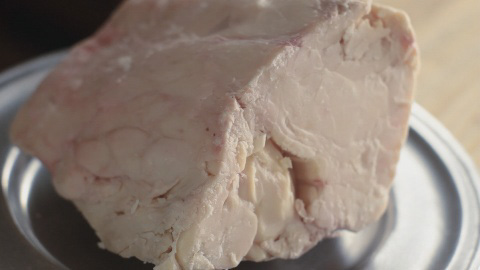
Beef suet
In my last post, I took a brief look at the important role suet had in 18th century foodways also as in life in general. I gave an over-simplified explanation that suet is the hard fat from the loins of beefiness and mutton. I'd like to add a piffling more than meat, so to speak, to that definition.
Beef suet can sometimes be a bit difficult to detect here in the United states. I doubtable that much of it ends up rendered, mixed with peanut butter and birdfeed, and packaged into blocks of winter-time bird food. Suet is a perfect high-caloric attraction for all my feathered friends who decide to stick out the cold northern winter with me.
I recently stopped at a well-respected butcher's shop in the area. After my unsuccessful search for suet at five local grocery store meat departments, I was pleased when the butcher trotted out of the libation with a 10-pound bag of the white stuff. My pleasure turned to disappointment, nonetheless, when I opened the bag at home to discover that he had just hoodwinked me with 10 pounds of hard muscle fatty. It's not the same thing.
Real suet is located on the inside of loin area of cattle and sheep. It is the hard fat that surrounds the animal's kidneys. If yous ask your butcher for suet, be sure he or she understands that y'all want kidney fat.
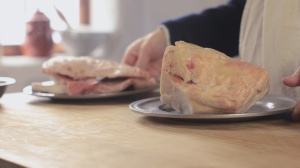
Muscle fat (left), suet (right)
The difference between difficult musculus fat and kidney fatty may not be all that apparent upward forepart. They both can be quite strong and look much alike. The existent difference tin can seen during and following the rendering process.
Suet, as opposed to muscle fat, contains a higher level of a triglyceride known as glyceryl tristearate, otherwise known as stearin. The result is that suet has a higher melting point and congealing bespeak than regular fat.
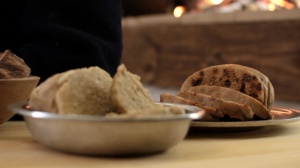
Boiled Puddings
This little point of trivia is important in guild to sympathize the former English recipes. Suet is grated or picked into minor pieces every bit part of the process of preparing it for cooking. When mixed with other ingredients — let's say the a batter for a traditional boiled pudding, the particles of suet retain their mass well into the cooking procedure. When the melting point of suet is finally reached, the surrounding concoction has already begun to set. Past the time full blistering temperature is reached within the pudding, the suet has melted, leaving a void in the batter.
Consequently, the utilise of suet in such dishes every bit puddings, dumplings, and mince pie results in a spongy texture. If the lower-melting muscle fat is used in suet'south place, the fatty will cook before the batter has a chance to set, resulting in a much heavier final issue.
Non only is suet used for textural purposes, just it is also used to add moisture to the dish without adding a strong meaty season that is and so common with muscle fatty. Suet has a much milder flavor.
I went ahead, for experimentation purposes, and rendered some of the musculus fat the butcher passed off to me as suet. Beyond the fact that my entire house smelled for three days like i behemothic broiled steak, the rendered fat I ended upwards with resembled a side dish of my grandma's runny mashed potatoes. Merely unlike my grandma's mashed potatoes, my rendered musculus fatty never hardened, fifty-fifty when it was cold.
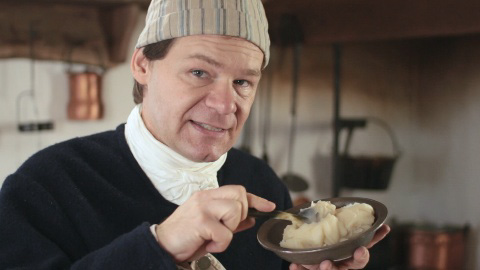
Jon with a bowl of rendered muscle fatty
This may seem strange, but I more often than not keep a couple of gallons of commercially rendered tallow within reach here at the part. I use it to make a couple of products here at Jas. Townsend & Son. "Tallow" is a general term that ways rendered fatty. Tallow can be made from suet, or musculus fatty, or a combination of both. The texture of tallow varies broadly, however, depending on the raw form of fatty from which its fabricated. So if yous find yourself someday in the reenacting mood to brand tallow candles, this is an important flake of information to know. You simply cannot make candles with tallow rendered from muscle fat.

Jon with a solid bar of rendered suet
Rendered suet, on the other hand, will congeal into a solid chunk. (I'll talk near the actually rendering process in my side by side postal service.) The chunk I fabricated felt like a bar of beauty soap. Mix rendered suet with a little lye and a chemical reaction occurs that results in h2o-soluble sodium stearate — the primary ingredient in almost manus soaps.
Oh, 1 other thing: Simply like beef muscle fat, pork lard is an unsatisfactory substitute for suet. You lot may have a difficult fourth dimension distinguishing by sight between a lump of lard and a lump of suet tallow, simply don't even think about using information technology as a substitute.
At present in my previous mail on 18th century Christmas pies, as well equally in the accompanying video, we suggested using vegetable shortening as a suet substitute. Admittedly, it's not a very expert substitute, merely it does provide the moisture without adding a stiff flavor.
The trouble is that while vegetable shortening'southward melting point is relatively the same every bit suet, its congealing point is much lower. What that means is this: when we shot the video, nosotros had to freeze the vegetable shortening in order to grate it. Then we had to go along it frozen until the very last second. But even and so, the moment we added the grated vegetable shortening to the other ingredients, information technology lost its mass and acted like room-temperature butter, blanket the other ingredients rather than retaining its particle shape. The final result was nevertheless a delicious pie, simply information technology didn't have the desired spongy texture that would have resulted from using suet.
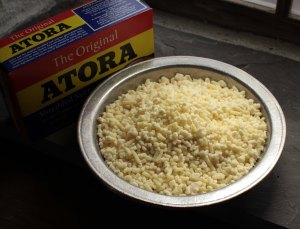
Now, if you live in the U.M., you're probably wondering why I suggest going through the hassle of dealing with raw suet when all you have to do is stroll down to the corner grocer and pick upwardly a box of processed suet. While I'1000 sure there are stores here in the States that sell this product, I sure tin can't find it here in northern Indiana. We had to go online to buy a box, which ended upwardly going through customs to get here.
If you decide to use this processed product in your 18th century foodie experiments, beware that it uses wheat flour (15% by weight) as a stabilizer to improve its ability to retain its shape. From a historical-accuracy standpoint, the addition of flour may be perfectly legitimate. William Kitchiner, in his 1817 volume, "The Cook's Oracle," suggests that during hot weather condition, shredded suet should be dredged with flour — apparently to stabilize its mass retention.
The caveat I offer is that if you lot are already using flour in your 18th century recipe in improver to that used in candy suet, you may take to make a minor adjustment to the amount of flour in lodge to get accurate results. Modern recipes that call for suet, by the manner, already accommodate this additional flour.
And finally, when shopping for suet, effort to get the whitest suet you lot tin can notice. This little tidbit is reiterated throughout the one-time cookbooks. Suet tends to turn a buttery yellow as it ages, and every bit it does, information technology also takes on a stronger flavor. Most beefiness offered for sale here in the States is aged. This may pose an additional claiming in finding fresh suet. A processor who actually slaughters the creature is probably your all-time bet for finding the freshest suet. A light buttery colored yellow suet is still usable, just a clean white suet is preferred. And for goodness sake, don't accept suet that is chocolate-brown or massively encarmine. That may be fine for the birds, just it'south unsuitable for cooking.
In my next post, I'll examine more closely how to process suet for utilise in cooking.
Source: https://savoringthepast.net/2013/01/21/suet-part-two-what-it-is-what-it-isnt-and-what-to-look-for/#:~:text=The%20real%20difference%20can%20seen,congealing%20point%20than%20regular%20fat.